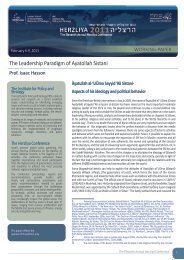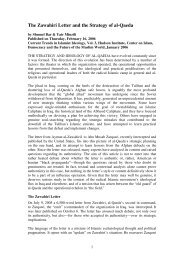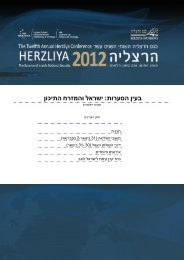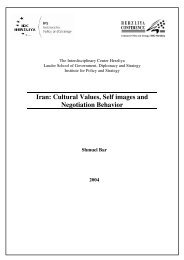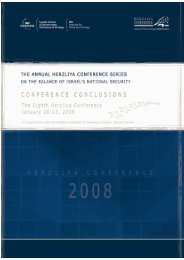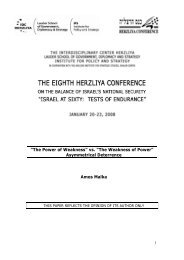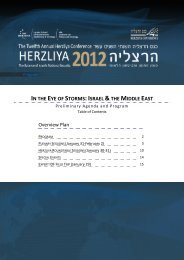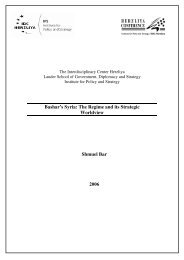Classical Islamic Paradigms of Deterrence and their Expression in ...
Classical Islamic Paradigms of Deterrence and their Expression in ...
Classical Islamic Paradigms of Deterrence and their Expression in ...
Create successful ePaper yourself
Turn your PDF publications into a flip-book with our unique Google optimized e-Paper software.
Furthermore, Sunni-jihadi deterrence is characterized by perceptions <strong>of</strong> tribal endemic warfare <strong>and</strong>terrorist tactics. The reason is the strong focus <strong>of</strong> jihadis on example cases from early Islam, when Muslimsdeveloped from endemic to imperial warfare. These are taken as conceptual cornerstones by today’s Sunnifighters to develop patterns <strong>of</strong> deterrence. However, deterrence strategies <strong>and</strong> patterns are not only basedon frighten<strong>in</strong>g the enemy. There exists also a perception <strong>of</strong> fright <strong>in</strong> the m<strong>in</strong>d <strong>of</strong> the actor himself. Inreligious sub-culture, transcendental <strong>and</strong> concrete fears can be clearly discerned. It is the role <strong>of</strong> reformeddeterrence strategists to exploit this Achilles Heel, i.e. the fear <strong>in</strong> the m<strong>in</strong>d <strong>of</strong> the opponent. Deal<strong>in</strong>g withmilitant religious sub-state actors <strong>in</strong> the <strong>in</strong>formation age means to transit from conventional to alternativedeterrence approaches. L<strong>in</strong>guistic <strong>and</strong> psycho-religious approaches are required to address <strong>their</strong> fears,while viable non-conflict <strong>and</strong> conciliation policies must address Muslim populations <strong>and</strong> respective metacultures.Military deterrence aga<strong>in</strong>st Muslim non-state actors has worked so far only <strong>in</strong> geographically limitedenvironments (Occupied Palest<strong>in</strong>ian Territories), with terrible prices for the local civilian population<strong>in</strong>volved. Military deterrence aga<strong>in</strong>st jihadi sub-state actors <strong>in</strong> larger Muslim regions lacks viable results.Firstly, jihadi culture nurtures on martyrdom mythology; gett<strong>in</strong>g passively killed by the enemy (by targetedassass<strong>in</strong>ations) is rather a reward than a punishment. Secondly, Western security cooperation aga<strong>in</strong>stjihadis is <strong>of</strong>ten comb<strong>in</strong>ed with military campaigns aga<strong>in</strong>st local Islamist <strong>and</strong> nationalist forces, for example,<strong>in</strong> Iraq <strong>and</strong> <strong>in</strong> Afghanistan. Such actions further fuel Muslim anger aga<strong>in</strong>st local governments <strong>and</strong> Western<strong>in</strong>volvement: both jihadi <strong>and</strong> <strong>in</strong>surgent agendas feed on this anger, f<strong>in</strong>ally both group<strong>in</strong>gs become evermore ideologically united.Reformed deterrence paradigms should address religious-psychological fears <strong>of</strong> jihadis (ittiqa'; khauf),which prohibit actively seek<strong>in</strong>g martyrdom. At the same time, complementary conciliation policies <strong>in</strong>parallel should address non-jihadi Muslims <strong>and</strong> local host populations. The key for a successful deterrencestrategy aga<strong>in</strong>st jihadi sub-state actors is to underst<strong>and</strong>1. Jihadi <strong>in</strong>-group-culture (rootedness <strong>in</strong> neo-tribalism <strong>and</strong> <strong>in</strong>formation-age fundamentalism);2. Jihadi deterrence (rootedness <strong>in</strong> "pre-terrence" based on neo-endemic warfare perceptions);3. Jihadi sectarian cultism <strong>and</strong> martyrdom (rootedness <strong>in</strong> perceptions <strong>of</strong> fear <strong>and</strong> reward);4. <strong>Deterrence</strong> as a defense strategy that developed out <strong>of</strong> primordial patterns <strong>of</strong> human behavior(rootedness <strong>in</strong> threat-display; rituals that glue groups together; re-emergence <strong>of</strong> these rituals <strong>in</strong>virtual space).Religious-psychological deterrence is based on communicative condition<strong>in</strong>g <strong>and</strong> <strong>in</strong>formation-target<strong>in</strong>g <strong>of</strong>root-myths <strong>and</strong> beliefs.Israel, for example, has "perfected" a concept that comb<strong>in</strong>es security control with deterr<strong>in</strong>g measures suchas collective punishment (house demolitions) <strong>and</strong> tactical deterrence by punishment (targetedassass<strong>in</strong>ations versus Palest<strong>in</strong>ian terrorist attacks). However, democratic state alliances can <strong>and</strong> may notapply the same model to the deterrence <strong>of</strong> salafi-jihadis on an <strong>in</strong>ternational level, i.e. collective punishmentas legitimate means <strong>of</strong> deterrence. It is logistically impossible <strong>and</strong> by all st<strong>and</strong>ards <strong>of</strong> International Lawillegitimate to control or punish larger regions <strong>and</strong> populaces <strong>in</strong> response to attacks or threats by non-stateactors. This is a key problem. The arrest <strong>and</strong> deportation <strong>of</strong> Muslim non-state actors <strong>in</strong>to states whichtorture, such as Abu Musab al-Suri to Syria <strong>in</strong> 2005, may have an effect on <strong>in</strong>dividuals. But they do notwitness a deterr<strong>in</strong>g effect on the jihadi movement as a whole. Western Cold War deterrence paradigms(state vs. state, bloc vs. bloc) do not function aga<strong>in</strong>st non-state actors. In case <strong>of</strong> jihadi terrorist threats,Western states pose themselves the question, whom to counter-attack. The problem was clearly2



